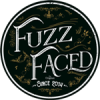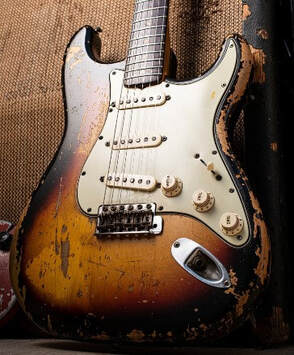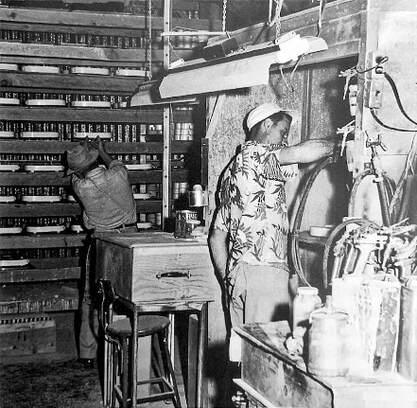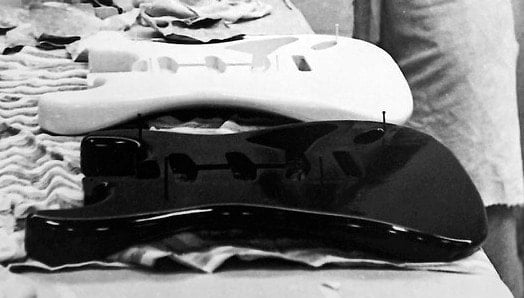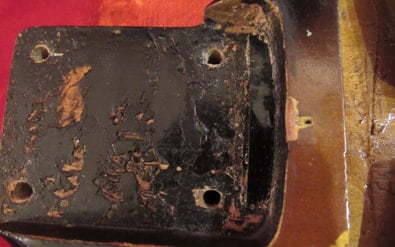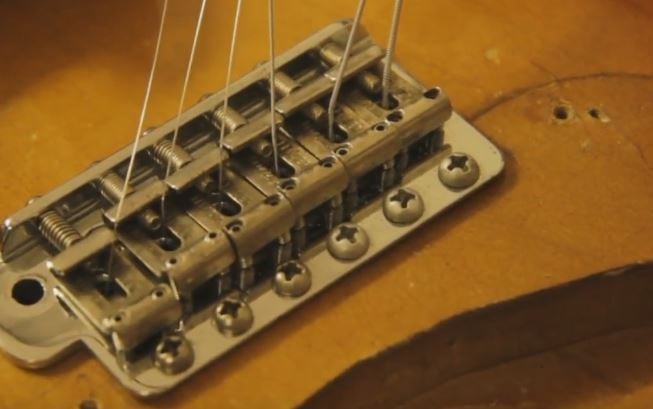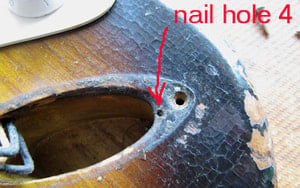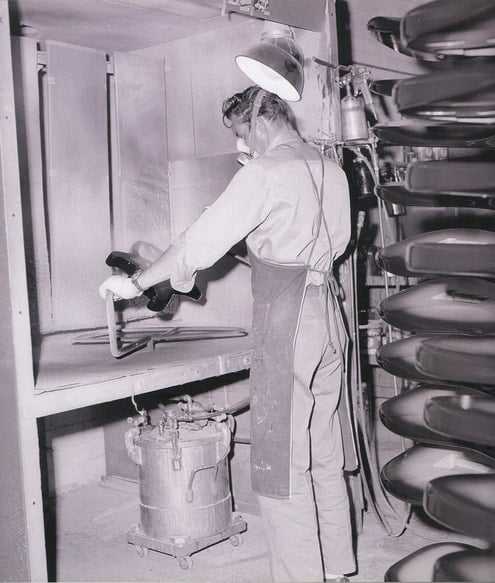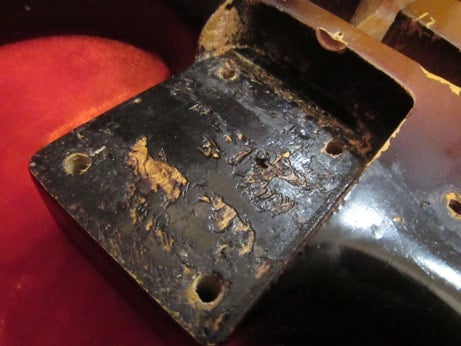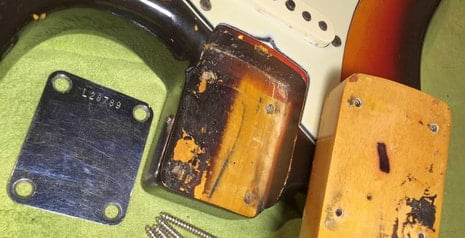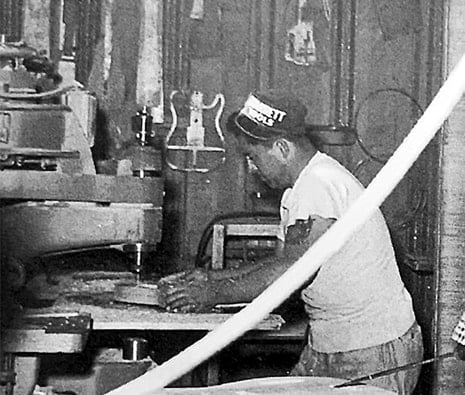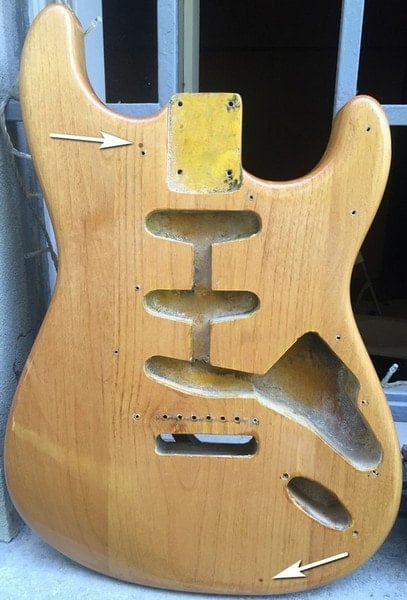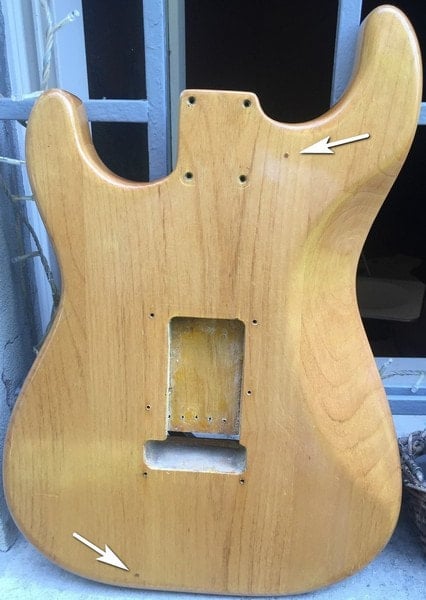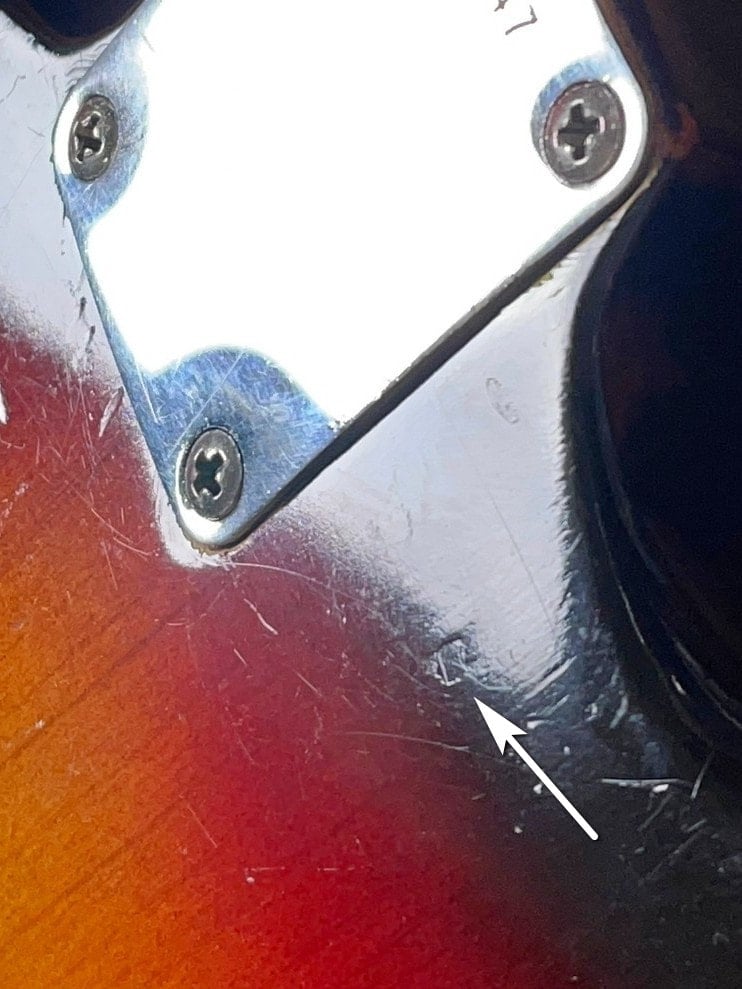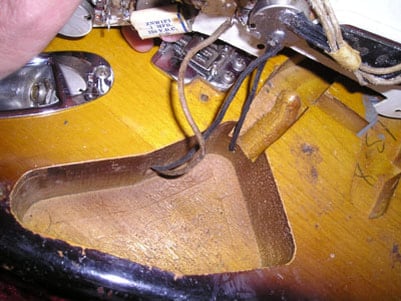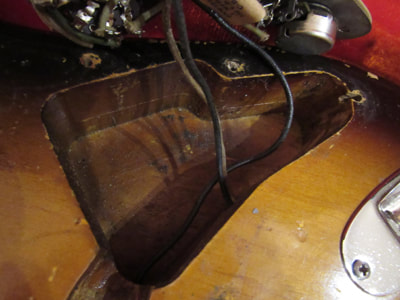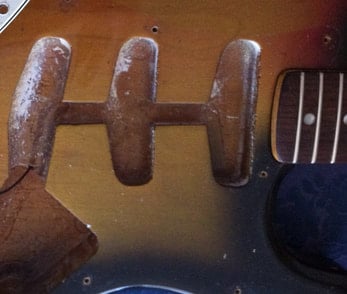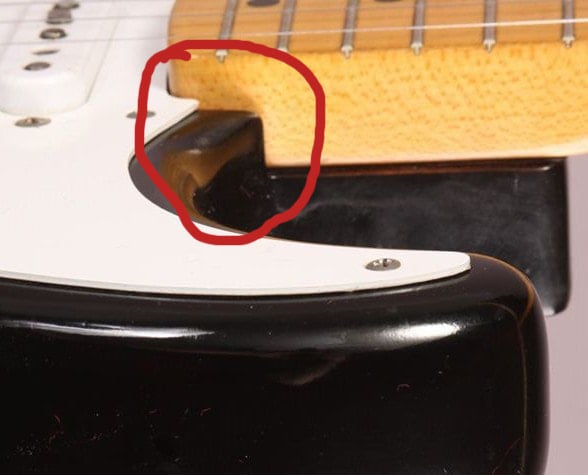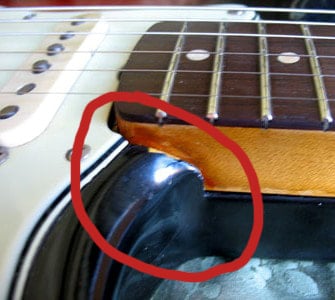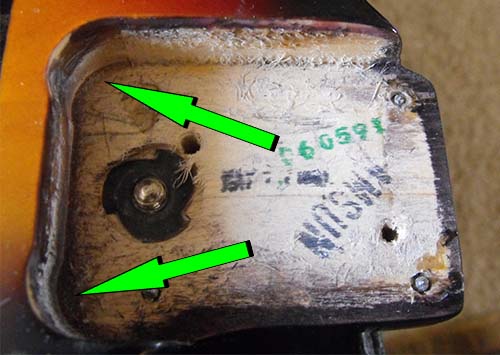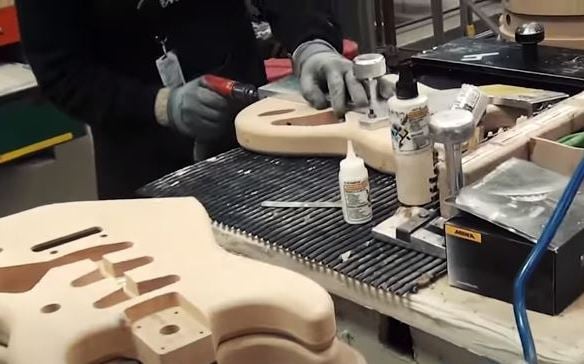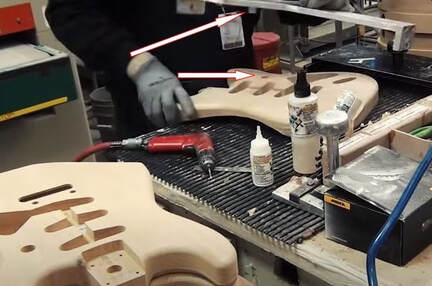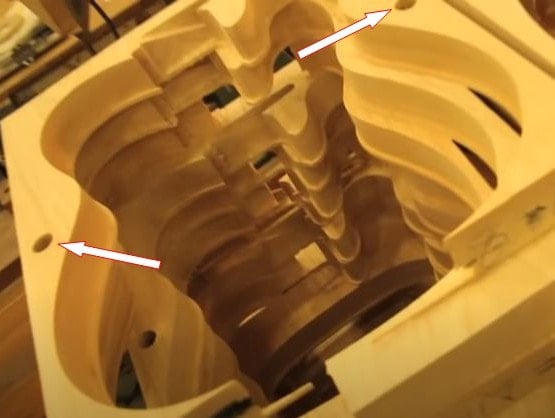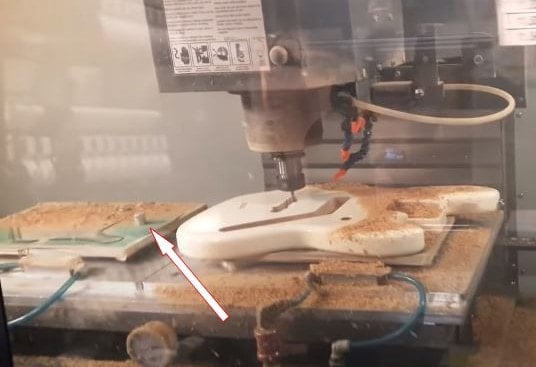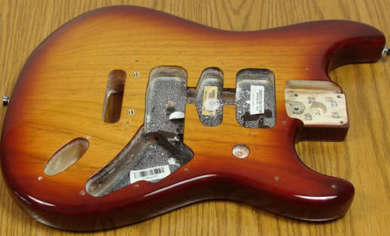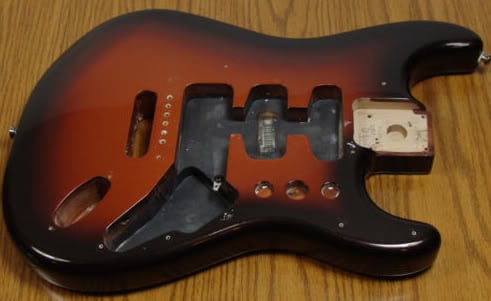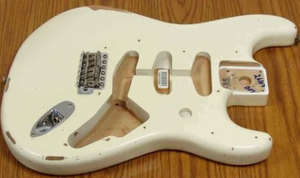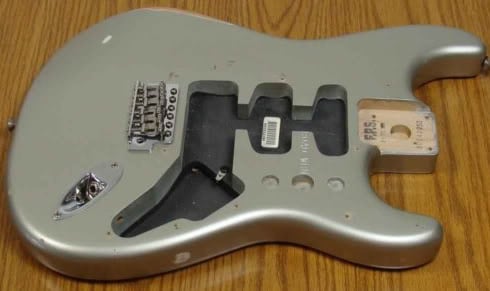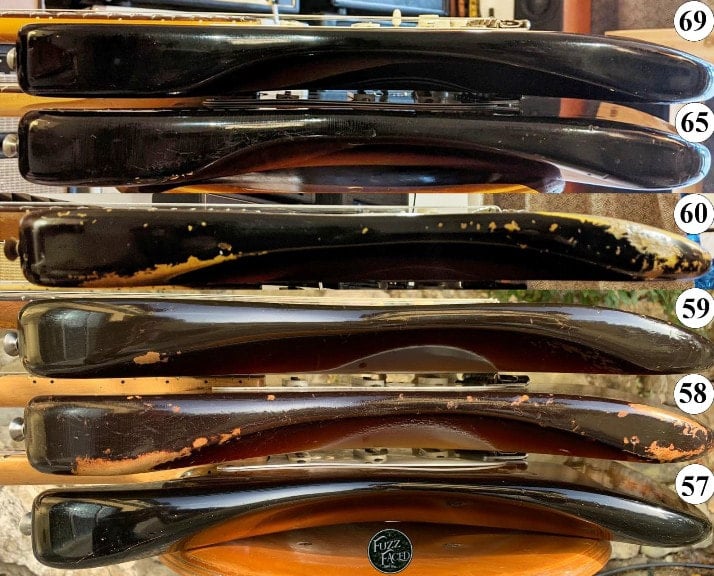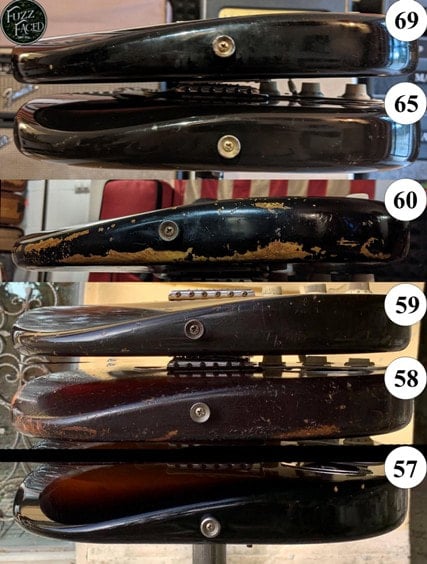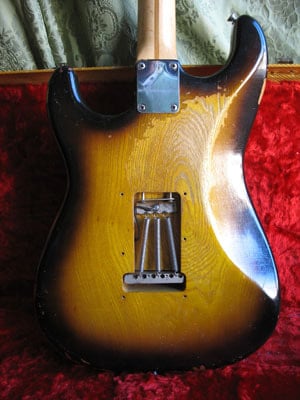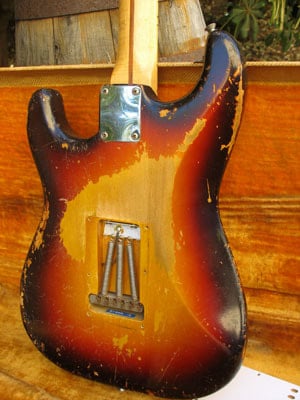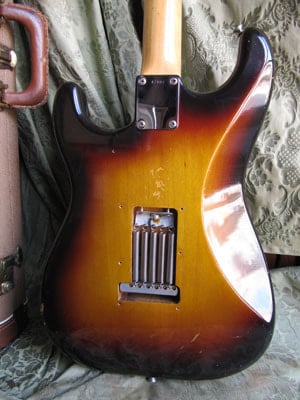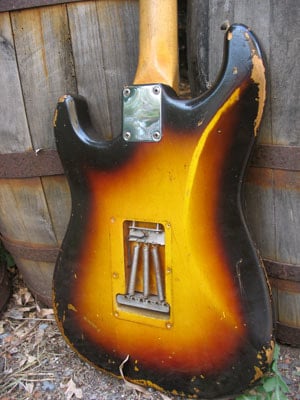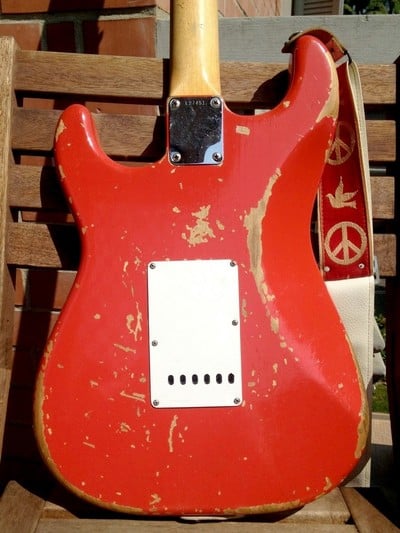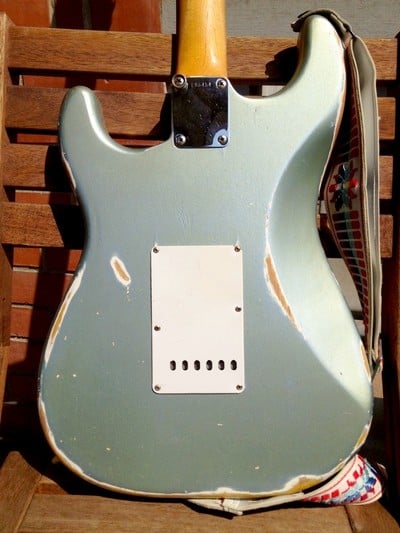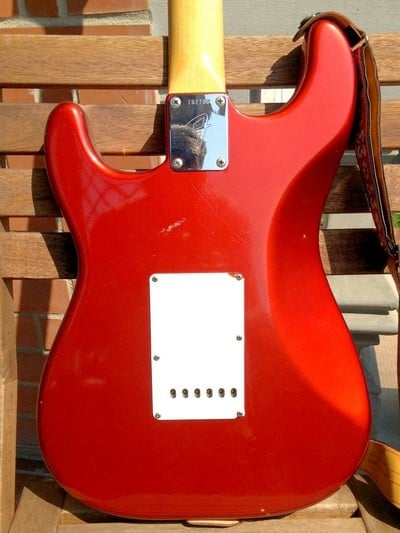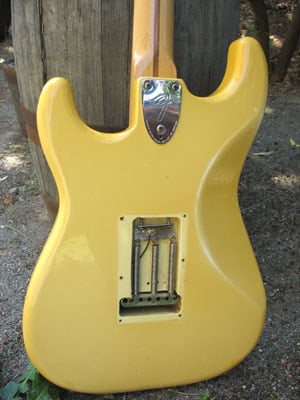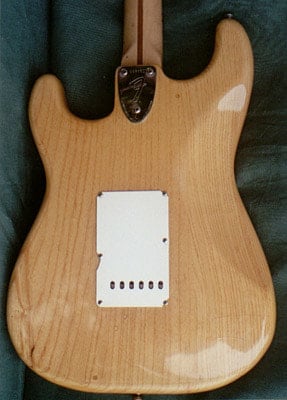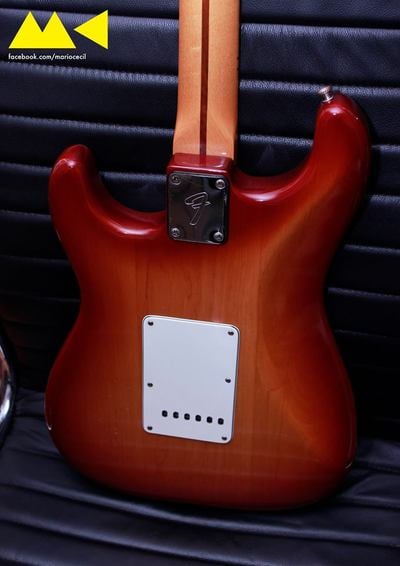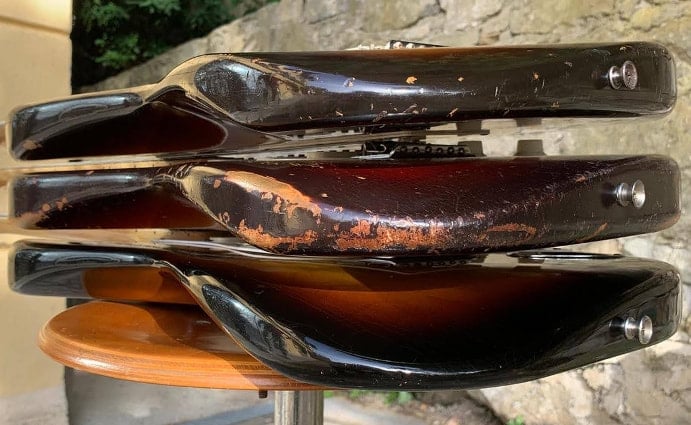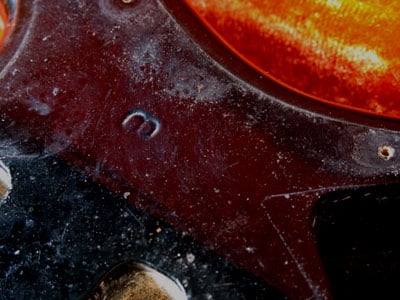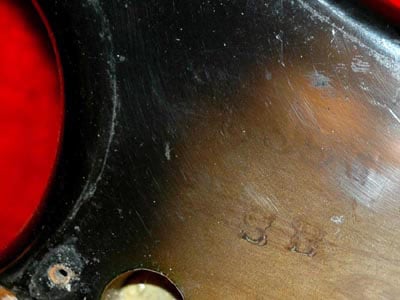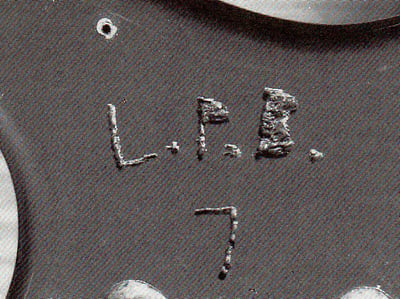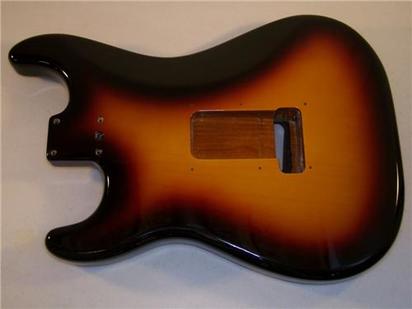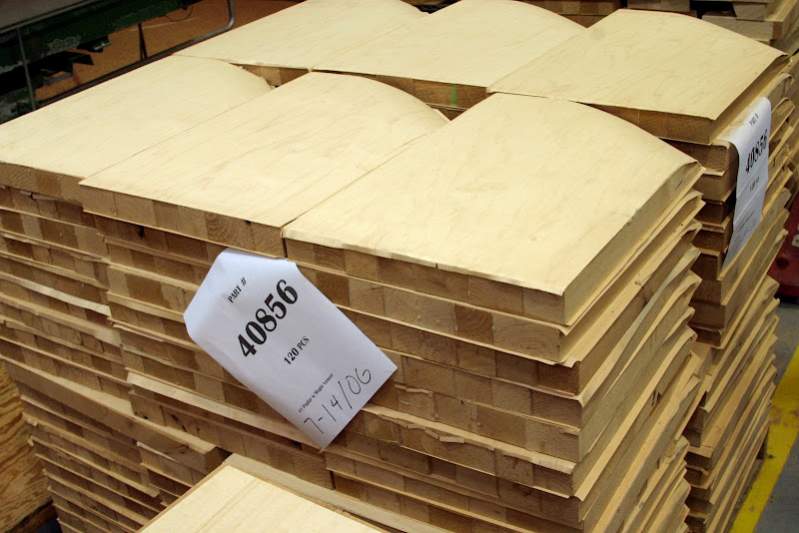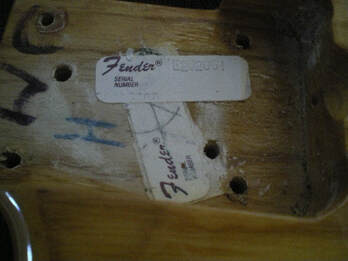WOOD MATERIAL
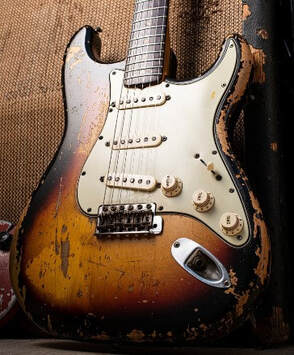 Photo Courtesy Eddie Tatton
Photo Courtesy Eddie Tatton
The first Stratocasters featured Northern White Ash (Fraxinus Americana) and Red Ash (Fraxinus Pennsylvanica) bodies generally made of two or three pieces (although one-piece bodies are known to exist) often meticulously matched to emphasize its grain patterns.
Furthermore, a recent laboratory analysis (reported here) have shown that in 1954, Kalopanax Septemlobus was also used (commonly known by the nickname Sen Ash, although it had nothing to do with ash).
Ash is an inconsistent timber. It can sport some striking grain patterns and may appear very light or it can be pretty plain and heavy. Its grain and its weight depend both on where the tree grows and which portion of the tree is used to cut the body. Generally speaking, the more water is absorbed by the tree, the lighter the eventual wood spread. When saturated with water the grain gets wider but, as the water recedes under warmer weather, the wood dries out and becomes much lighter. Usually, the bottom portion of the tree usually absorbs more water, particularly during winter, than the top portion.
So, the term “swamp ash” does not refer to any particular species of ash as often reported, but is generally used by luthiers to describe lightweight wood yielded from ash trees which are usually found in wet or swampy areas, and obtaining light and figured ash is not a question of luck, but a matter of specifications and price when ordering wood.
Since weight was not a prime consideration when procuring ash, you can find Fender Stratocaster bodies of variable density. As a general rule, ash bodies from the '50s were lighter on the average than those from the '70s, which were particularly inconsistent.
In mid-1956, Fender started using alder for all the Stratocasters that were not finished in blond, because it was less porous and therefore easier to paint. Moreover, it is fast growing and readily available.
The only exceptions were the blond Stratocasters, which retained an ash body because their semi-transparent finish allowed highlighting its beautiful grain.
Alder is a uniform textured wood with straight grain patterns. It has a reddish tint which makes it unique and pleasing. As it is not a very big tree, alder bodies were usually made of three or, rarely, four or even more pieces, although 2-piece alder body Stratocasters are known to exist.
In early 1972, the introduction of the Natural finish prompted the return of ash, which was preferred to alder because of its grain. The transition was gradual and, at first, both ash and alder bodies were used.
Finally, with the return to fashion of solid colors at the dawn of the '80s, the ash was almost completely set aside in favor of the alder.
Between 1963 and 1964 some - very few, actually – Stratocaster bodies were made in mahogany, others in korina. The use of this wood was probably due to the fact that Leo Fender had bought a low-priced stock of korina. In 1982 about two hundred "Smith Strats" featured a hackberry body, instead of alder, for its more attractive grain which fit well with transparent finishes.
After the closure of Fullerton factory, Fender continued to use mostly ash and alder for the body of the Stratocasters made in the USA. In the first '90s, due to the deforestation restrictions in Oregon, tulip poplar also was used for US Strats. Fender has widely used this timber also in many Stratocasters made in Mexico.
Furthermore, a recent laboratory analysis (reported here) have shown that in 1954, Kalopanax Septemlobus was also used (commonly known by the nickname Sen Ash, although it had nothing to do with ash).
Ash is an inconsistent timber. It can sport some striking grain patterns and may appear very light or it can be pretty plain and heavy. Its grain and its weight depend both on where the tree grows and which portion of the tree is used to cut the body. Generally speaking, the more water is absorbed by the tree, the lighter the eventual wood spread. When saturated with water the grain gets wider but, as the water recedes under warmer weather, the wood dries out and becomes much lighter. Usually, the bottom portion of the tree usually absorbs more water, particularly during winter, than the top portion.
So, the term “swamp ash” does not refer to any particular species of ash as often reported, but is generally used by luthiers to describe lightweight wood yielded from ash trees which are usually found in wet or swampy areas, and obtaining light and figured ash is not a question of luck, but a matter of specifications and price when ordering wood.
Since weight was not a prime consideration when procuring ash, you can find Fender Stratocaster bodies of variable density. As a general rule, ash bodies from the '50s were lighter on the average than those from the '70s, which were particularly inconsistent.
In mid-1956, Fender started using alder for all the Stratocasters that were not finished in blond, because it was less porous and therefore easier to paint. Moreover, it is fast growing and readily available.
The only exceptions were the blond Stratocasters, which retained an ash body because their semi-transparent finish allowed highlighting its beautiful grain.
Alder is a uniform textured wood with straight grain patterns. It has a reddish tint which makes it unique and pleasing. As it is not a very big tree, alder bodies were usually made of three or, rarely, four or even more pieces, although 2-piece alder body Stratocasters are known to exist.
In early 1972, the introduction of the Natural finish prompted the return of ash, which was preferred to alder because of its grain. The transition was gradual and, at first, both ash and alder bodies were used.
Finally, with the return to fashion of solid colors at the dawn of the '80s, the ash was almost completely set aside in favor of the alder.
Between 1963 and 1964 some - very few, actually – Stratocaster bodies were made in mahogany, others in korina. The use of this wood was probably due to the fact that Leo Fender had bought a low-priced stock of korina. In 1982 about two hundred "Smith Strats" featured a hackberry body, instead of alder, for its more attractive grain which fit well with transparent finishes.
After the closure of Fullerton factory, Fender continued to use mostly ash and alder for the body of the Stratocasters made in the USA. In the first '90s, due to the deforestation restrictions in Oregon, tulip poplar also was used for US Strats. Fender has widely used this timber also in many Stratocasters made in Mexico.
NAIL HOLES AND PAINT STICK
|
All pre-CBS Fender Stratocaster bodies that date from before the end of 1964 have three or four 1/16” nail holes on the front. Fender used the nails as spacers for the painting/drying process. Before applying the finish, three or four small nails were hammered into the body face. The body was therefore arranged on a turntable called “Lazy Susan” and was painted on the top. Then the body was flipped over onto the nails in order to paint the back and sides of the body. The painted body was left on its nail legs to dry. When the finish was dry, the nails were removed, thus leaving small holes free of paint, called nail holes or clamping holes. However, since the body was rubbed out after the nails were removed, nail holes may have some white or pink rubbing compound junk in them.
Since the end of 1964 Fender changed the painting process and the nails were no more used. Thus, clamping holes may help to authenticate pre-CBS bodies and to distinguish them from modern reissues or fakes. The presence of paint (and not of pink rubbing compound) inside nail holes indicates that the guitar has been refinished. |
|
Nail holes were normally placed:
|
Around the end of 1962, with the purpose of rotating the body in the spray booth for easy spraying and drying operations, Fender started to use a paint stick, a piece of an electrical conduit pipe. It was screwed in the neck pocket in the two bass-side screw holes after the application of yellow and before spraying the other colors. Therefore, the area under the stick in the neck pocket remained yellow, whilst, prior to the paint stick, the neck pocket was completely painted. The other side of the stick was put around a freehand rotating tool so that the body could be turned in all directions during the painting process. It's important to bear in mind that nails were still used for the drying process, but since the end of 1964 they were replaced by a drying tree on which the sticks could be attached, which took up less space.
PIN ROUTER'S HOLES
|
From '50s until late '70s, Fender used a pin router and templates to cut guitars body edges and routes. Routing templates had locating pins to secure them onto the underside of the body blanks. When the template was lifted off, small holes (0.125", 3.175 mm) were filled with hardwood dowel and then leveled.
The pin router's holes, or dowel holes, are different from the nail holes and obviously are always in exactly the same place. If the guitar is not hard tail, they went all the way through the body because Fender's employees had to screw templates onto both sides of the body. Usually, they are not easy to spot on a painted body because they were well patched up and camouflaged. However, old nitro finishes were really thin and, observing carefully the body surface, the dowel outlines can be seen through the finish. |
Dowels can be spotted on the body of the Stratocaster in two places:
However, Vintage reissue and on some Custom Shop guitars were still made with the old pin router and therefore they still featured dowel holes.
It should be noted that pin router's holes were in completely different positions on the Telecaster.
A dowel hole can also be found on the headstock, under the G and D tuning machines.
- Near the neck plate and the upper horn cutaway.
- At the bottom end of the body, slightly offset.
However, Vintage reissue and on some Custom Shop guitars were still made with the old pin router and therefore they still featured dowel holes.
It should be noted that pin router's holes were in completely different positions on the Telecaster.
A dowel hole can also be found on the headstock, under the G and D tuning machines.
ROUTINGS AND TOOLING HOLES
The control cavity under the pickguard of the first Stratocasters didn’t have the typical “shoulder” which appeared in mid-1959 to accommodate the screw used of the new 11-hole pickguards.
The control cavity under the pickguard of the first Stratocasters didn’t have the typical “shoulder” which appeared in mid-1959 to accommodate the screw used of the new 11-hole pickguards.
The body of the vintage Stratocasters had single route for each pickup. The size of these cavities was usually, in pre-CBS Stratocasters, between 86.5mm - 86.98mm long and 24.98mm and 25.6mm wide. At first their edges were particularly rounded, but in late 1969 pickup routing changed to a slightly more squared version because the heavier poly finish primer made impossible for the employees to install the loaded pickguards correctly. Some mid-1969 Stratocaster bodies were sprayed with the new primer but still retaining the old rounded routes design and thus needed to be re adjusted at the factory before installation. Furthermore, since 1970 pickup cavities became slightly bigger.
Since 1972, an additional "shielding" graphite-based black paint could be applied on pickup and electronics cavities on request.
Inside the cavity of the bridge pickup there was an additional small channel done with a ball-shaped router bit, called ball route or worm route, which was used to better accommodate bridge pickup wires. Some of the first 1954 Stratocasters didn’t have it, because early strat necks tended to sit higher in the neck pocket, which required pickups to be adjusted higher and thus left plenty room in the bridge pickup cavity. Other early 1954 Stratocasters featured an unfinished worm route because it was crudely added once the body had already been lacquered. However, the first Stratocaster with a painted worm route are dated late 1954.
Since 1974 onwards Fender had increased the depth of the pickup cavities and it had been no longer necessary to dig this slot.
As you can see in the photo the neck pocket of the 1954 Stratocasters had a different shape from that of subsequent productions: it was characterized by a sharp angle of 90° on the side near the lower horn.
The body of the vintage Stratocasters had single route for each pickup. The size of these cavities was usually, in pre-CBS Stratocasters, between 86.5mm - 86.98mm long and 24.98mm and 25.6mm wide. At first their edges were particularly rounded, but in late 1969 pickup routing changed to a slightly more squared version because the heavier poly finish primer made impossible for the employees to install the loaded pickguards correctly. Some mid-1969 Stratocaster bodies were sprayed with the new primer but still retaining the old rounded routes design and thus needed to be re adjusted at the factory before installation. Furthermore, since 1970 pickup cavities became slightly bigger.
Since 1972, an additional "shielding" graphite-based black paint could be applied on pickup and electronics cavities on request.
Inside the cavity of the bridge pickup there was an additional small channel done with a ball-shaped router bit, called ball route or worm route, which was used to better accommodate bridge pickup wires. Some of the first 1954 Stratocasters didn’t have it, because early strat necks tended to sit higher in the neck pocket, which required pickups to be adjusted higher and thus left plenty room in the bridge pickup cavity. Other early 1954 Stratocasters featured an unfinished worm route because it was crudely added once the body had already been lacquered. However, the first Stratocaster with a painted worm route are dated late 1954.
Since 1974 onwards Fender had increased the depth of the pickup cavities and it had been no longer necessary to dig this slot.
As you can see in the photo the neck pocket of the 1954 Stratocasters had a different shape from that of subsequent productions: it was characterized by a sharp angle of 90° on the side near the lower horn.
The American Standard Strats, unveiled in 1987, had, differently from the previous standard models, a single large compartment to accommodate the pickups, called swimming pool. However, in 1998, bodies with the HSH routing started circulating and in 1999 they definitely replaced the swimming pool in this Series.
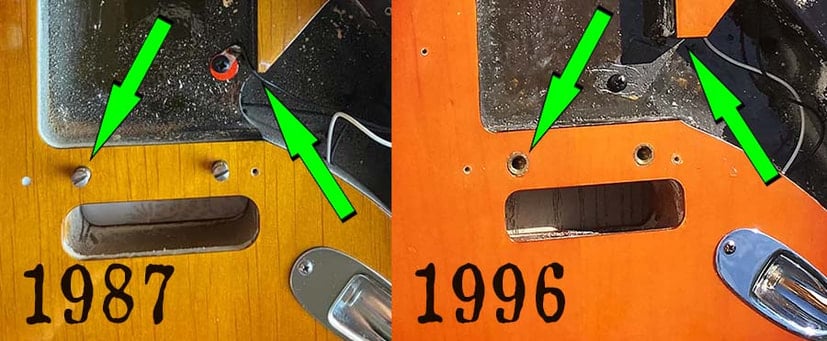
In comparing the 1986-early 1987 and all the other American Standard Strats, it's notable that the very first units featured a sharp corner between the swimming pool and the control route. Additionally, these early units are distinguishable because the bridge pivots entered directly into the wood, whereas in all other American Standard Stratocasters, they passed through a metal ferrule inserted into the body
|
Since the late ‘70s, the neck pocket routing often featured oversized corners hidden by the pickguard, which some have coined “Micky Mouse”. In fact, in the late ‘70s Fender switched the size of the pin router cutter to 3/4” diameter instead of the smaller 1/2” because a larger diameter cutter cuts a smoother and cleaner surface and lasts longer. However, the shape of neck heel was different from the new pocket routed with the 3/4” pin router cutter, so they started to make this new neck pocket with oversized corners. Fender continued to make this strange neck pocket in the ‘80s and early ‘90s, until the new CNC machines allowed to make the correct corners.
|
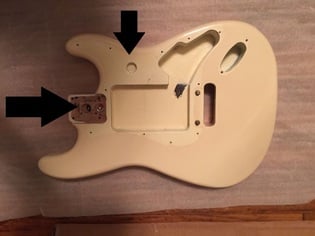 '90s American Standard Stratocaster Swimming Pool
'90s American Standard Stratocaster Swimming Pool
Around 1997 some circular holes began to appear in the neck pocket and below the pickguard, which engendered a long debate concerning their presence. While these holes do help to differentiate between USA and Ensenada made bodies, they are not done for the benefit of second-hand buyers or for any identification purposes at all!
Some people claim that they are hold down holes for the CNC, but Fender CNC routers use a vacuum hold down system. They are not indexing holes either: little pins and indexing holes are used to "index" the front side to the backside, preventing any misalignment, when the blank is flipped over to machine and are usually located in the scrap section of the body blank and go all the way through both sides of the blanks.
However, these strange holes are involved in the body working in many ways. In the picture is it possible to see how a template used to make strap buttons holes fits perfectly the hole under the pickguard. In another picture it is possible to see an Ensenada CNC machine with vacuum hold down system and a peg on the machine bed where the upside-down body could be engaged.
Some people claim that they are hold down holes for the CNC, but Fender CNC routers use a vacuum hold down system. They are not indexing holes either: little pins and indexing holes are used to "index" the front side to the backside, preventing any misalignment, when the blank is flipped over to machine and are usually located in the scrap section of the body blank and go all the way through both sides of the blanks.
However, these strange holes are involved in the body working in many ways. In the picture is it possible to see how a template used to make strap buttons holes fits perfectly the hole under the pickguard. In another picture it is possible to see an Ensenada CNC machine with vacuum hold down system and a peg on the machine bed where the upside-down body could be engaged.
Given that on the American Standard there were only one hole in the body and one in the neck pocket, in addition to those for the 2-point bridge, it is easy to distinguish it from other non-U.S.A. Stratocasters.
COMFORT CONTOUR BODY
One of the most important and revolutionary features of the Stratocaster was the Comfort Contour Body. Though some general lines on its evolution during the years can be traced, the contour could vary slightly from one unit to another. In fact, the body shaping was entrusted to the workers, who, even with the help of pin router machines and templates that allowed them to standardize the production, could get away from the original design according to the amount of work and to their own manual skill.
Broadly, the '50s bodies were those more shaped; in particular, the belly cut has never been deeper than that of the Stratocasters made between 1957 and 1959 - in the '50s the back contour started already from the upper horn. At the beginning of the '60s it began to become slightly shorter. The top contour follows about the same rules.
In the first CBS era the comfort contour remained unchanged, although some bodies made between 1970 and 1971 could be so shaped to recall those of the '50s. However, probably due to the transition to an increase in production accompanied by shorter production times and wear of machines, since then the contour has been further reduced to seem almost hinted compared to the deep one of the '50s, but, above all, it was not consistent and there could be a noticeable difference between one body and another, especially in the second half of the '70s. More attention was instead paid to special models, like the Strat or the Gold Stratocaster.
Since 1981 the bodies have returned to having a deeper contour. Despite some authors claim that it was due to purchase of the AB Shaper, the contour at that time was still made with the old belt-sanders and the change to deeper contour was intentional. In fact, Scott Zimmerman, luthier at Fender, asked senior engineers of R&D if he could make new bodies with different shapes. His samples were sent to Music Messe and NAMM, dealers liked them and requested the new contour style.
Broadly, the '50s bodies were those more shaped; in particular, the belly cut has never been deeper than that of the Stratocasters made between 1957 and 1959 - in the '50s the back contour started already from the upper horn. At the beginning of the '60s it began to become slightly shorter. The top contour follows about the same rules.
In the first CBS era the comfort contour remained unchanged, although some bodies made between 1970 and 1971 could be so shaped to recall those of the '50s. However, probably due to the transition to an increase in production accompanied by shorter production times and wear of machines, since then the contour has been further reduced to seem almost hinted compared to the deep one of the '50s, but, above all, it was not consistent and there could be a noticeable difference between one body and another, especially in the second half of the '70s. More attention was instead paid to special models, like the Strat or the Gold Stratocaster.
Since 1981 the bodies have returned to having a deeper contour. Despite some authors claim that it was due to purchase of the AB Shaper, the contour at that time was still made with the old belt-sanders and the change to deeper contour was intentional. In fact, Scott Zimmerman, luthier at Fender, asked senior engineers of R&D if he could make new bodies with different shapes. His samples were sent to Music Messe and NAMM, dealers liked them and requested the new contour style.
Comparison between Stratocaster's contours: from top to bottom, 1969, 1965, 1960, 1959, 1958, 1957 (Courtesy of Filippo Regoli)
|
Back Contour from '55 until '81. It was very deep in '50s (note the upper horn!) and, since the 1960, it was slightly less marked. After 1965 it strated to be shallower and shallower, expecially in the '70s. Since 1981 it was again deeper. (Picture: 55, 58, 59, 60, 72, 73/74 courtesy of Nino fazio, realvintage.it; 64, 65, 66/67 courtesy of ReCaster; 82 courtesy of Mario Cecil)
|
With the shift of production from Fullerton to Corona, the bodies of the Stratocasters started to have a less rounded and more squared shapes. However, some of the very first American Standard and very rare Strat Plus models still had the same "Fullerton contour" of the previous factory. As recalled by John Page, Fullerton bodies were not used on American Standard Strats and the only few warehouse leftovers recycled on the first models of the new post CBS ownership were the bodies of the Vintage reissue Stratocasters. However, it is possible to find some American Standards with the “Fullerton contour” because the very first models had been made with the old templates, but with different routing. They can be identified also because the pivots of the bridge entered the wood, differently from those with the “Corona contour” in which they passed through a metal ferrule. When Fender contacted Yngwie Malmsteen for the realization of his signature, the guitarist claimed for this model a less soft and more squared contour. Fender satisfied his request and changed the templates used for the Stratocaster body, both for the signature and for the American Standard Series and the other models.
Comparison between the rounded contour of a 1982 Fullerton Strat on the top (courtesy of Massimo Salmoiraghi) and the sharper contour of a 1988 Strat made in Corona, bottom (Courtesy of Francesco Palmitessa)
SIGNS ON THE BODY
On the body of the Stratocasters made roughly between 1959 and 1966, it is possible to see under the pickguard or in the neck pocket some letters or numbers engraved which mean a repair or a factory refinish on guitars brought back to Fender factory by guitarists who needed assistance. In addition to the numbers, some acronyms are also frequent, including S.B. (sunburst), L.P.B. (lake placid blue) and C.A.R. (candy apple red).
Usually letters and numbers mean a factory refin; from left to right: black, sunburst (realvintage.it), lake placid blue (Duchossoir)
'80S AND '90S american standard and plus VENEER BODIES
Since late 1989 ca., it often happened that below the solid colors, but also in some sunbursts (those with the entirely black back contour), there was a body composed by multiple pieces of wood hidden by a veneer top and back. According to George Blanda and Dan Smith, this would have served to make the color adhere better and prevent mineral deposits from sinking into the grain.
BODY DATES
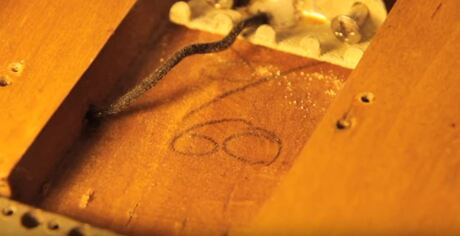
The Stratocasters made between 1954 and the end of 1963 usually exhibited the date of production (numerically indicated as M-YY) written by hand inside the tremolo cavity of the body, under the springs, or inside the cavity of the central pickup, above all between 1956 and 1958, but rarely even until 1960. However, since about 1963, when the custom color orders became more impressive, the body has hardly been dated.
Obviously, there are some exceptions, in particular on the Stratocasters made in the second half of the '70s and between the end of 1981 and the beginning of 1982: in these cases, however, the dates stamped or written in pencil in the neck pocket, inside the cavity of the pickup or directly on the bodies of the Natural Stratocasters, under the pickguard, referred to the quality check.
It was possible to find them in two formats: MM-DD-YY or WWYD, in which “WW” indicates the week, “Y” the year and “D” the day of the week, associated with another stamp depicting the circled "FRR" or "INSP", which indicated the quality control officer.
Obviously, there are some exceptions, in particular on the Stratocasters made in the second half of the '70s and between the end of 1981 and the beginning of 1982: in these cases, however, the dates stamped or written in pencil in the neck pocket, inside the cavity of the pickup or directly on the bodies of the Natural Stratocasters, under the pickguard, referred to the quality check.
It was possible to find them in two formats: MM-DD-YY or WWYD, in which “WW” indicates the week, “Y” the year and “D” the day of the week, associated with another stamp depicting the circled "FRR" or "INSP", which indicated the quality control officer.
Between the end of the '70s and the first '80s it was also frequent to find, inside the cavity of the pickup or in the neck pocket or behind the neck, small stickers indicating, in addition to the Fender logo, the serial number.
MASKING TAPES
Stratocasters manufactured between 1954 and 1956 usually featured a date penciled on a piece of masking tape located in the control cavity. These tape inscriptions were affixed either on the side or on the bottom of the cavity routing and marked the wiring harness were installed into the body. Therefore, they usually were the last date found on a Fender guitar.
Most of these inscriptions were signed with female first names such as Mary, Gloria, Virginia, or Barbara.
Most of these inscriptions were signed with female first names such as Mary, Gloria, Virginia, or Barbara.
